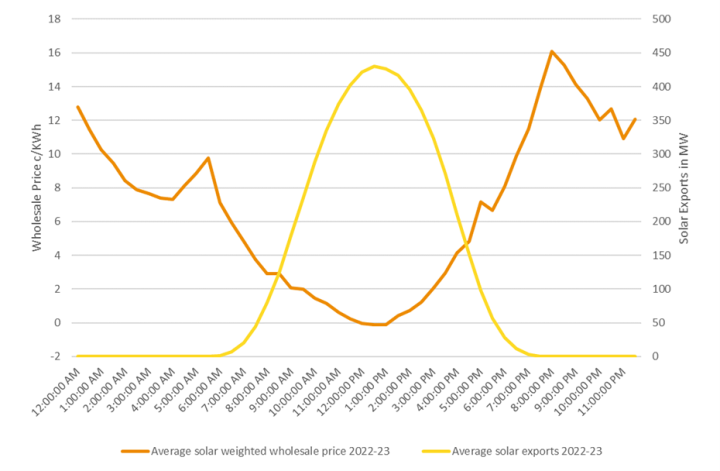The feed-in tariff is the amount that your energy company pays you for power you export to the grid. Energy companies choose the amount they pay but cannot pay you less than the minimum feed-in tariff we set.
Minimum feed-in tariff review 2024–25
-
Draft decision22 November 2023
-
Consultation closed22 December 2023
-
Final decision27 February 2024
-
Minimum tariffs in effectFrom 1 July 2024
Overview
We have completed our review of the 2024–25 minimum feed-in tariffs.
The 2024–25 minimum feed-in tariffs will apply from 1 July 2024.
Key facts about our final decision
The 2024-25 'flat' minimum feed-in tariff is 3.3 cents per kilowatt hour
The flat rate minimum feed-in tariff applies regardless of the time of day or day of the week.
There are two 'time-varying' minimum feed-in tariffs options
Under time-varying minimum feed-in tariff option 1, customers are credited between 2.8 cents and 7.6 cents per kilowatt hour of electricity exported, depending on the time of day.
Under time-varying minimum feed-in option 2, customers are credited between 2.1 cents and 8.4 cents per kilowatt hour of electricity exported, depending on the time of the day.
Wholesale prices during daylight hours are forecast to decline
The flat rate minimum feed-in tariff for 2024-25 is lower than that for 2023-24 due to lower daytime wholesale electricity prices.
While wholesale electricity prices on average have increased in recent years, they are forecast to decline in 2024-25. This is especially true for wholesale prices during the day. The increased number of households with roof-top solar has reduced demand and increased supply during daylight hours leading to reduced prices when most solar exports are occurring.
Although the proposed overnight and early evening tariff rates are higher than the day rates, they are also decreasing. This is because wholesale prices are currently forecast to be lower on average across all parts of the day in 2024-25.
The table below shows the minimum feed-in tariffs for 2024-25. Retailers can offer solar customers a flat feed-in tariff and/or time-varying feed-in tariffs for electricity exported to the grid.
| Flat minimum rate | ||
|---|---|---|
| At all times | ||
| 3.3 c/kWh | ||
| Time-varying minimum rates | ||
| Option 1 | ||
Overnight Weekdays: 10 pm to 7 am Weekends: 10 pm to 7 am | Day Weekdays: 7 am to 3 pm, 9 pm to 10 pm Weekends: 7 am to 10 pm | Early evening Weekdays: 3 pm to 9 pm Weekends: n/a |
| 7.6 c/kWh | 2.8 c/kWh | 7.0 c/kWh |
| Option 2 | ||
Shoulder Everyday: 9 pm to 10 am 2 pm to 4 pm | Off-peak Everyday: 10 am to 2 pm | Peak Everyday: 4 pm to 9pm |
| 4.1 c/kWh | 2.1 c/kWh | 8.4 c/kWh |
We have updated the inputs in the minimum feed-in tariff model since we released the draft decision. This reflects the most recent data available to us at the time of our final decision.
Why do the minimum feed-in tariffs change each year?
The video below provides a general explanation of what factors might impact changes in the minimum feed-in tariffs.
The minimum feed-in tariffs change each year mostly because of changes in solar weighted wholesale electricity prices.
We estimate solar weighted wholesale electricity prices using the latest information available at the time of publication of each decision. In recent years, solar weighted wholesale electricity prices during the middle of the day, when most solar is exported, have been going down.
The wholesale price is set in a competitive national market, based on energy supply and demand. The wholesale price is not set by the government or a regulator.
The chart below shows how solar weighted wholesale electricity prices are low during the day, when most solar exports happen, but higher at night.
Tips to make the most of your solar
The enduring value for solar customers is avoiding paying retail prices when using the energy they produce themselves.
- Where possible, run your power-hungry appliances - washing machines, dishwasher - during the middle of the day to avoid higher evening peak prices charged by retailers. Any leftover energy is then exported to the grid and you get paid via the feed-in tariff.
- Consider the advantages (and disadvantages) of 'time of use' feed-in tariffs when working out which energy retailer meets your needs. Also beware that a higher feed-in tariff may mean you pay higher import tariffs.
- Plan your daily energy usage to be met during daylight hours when your solar is hard at work.


